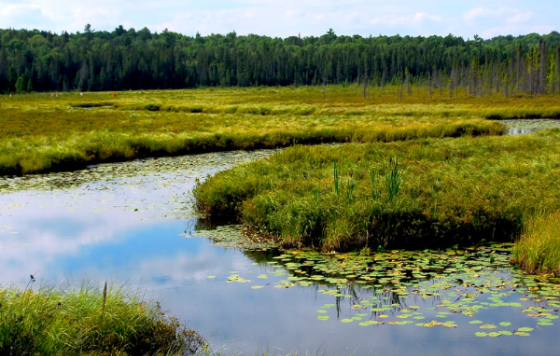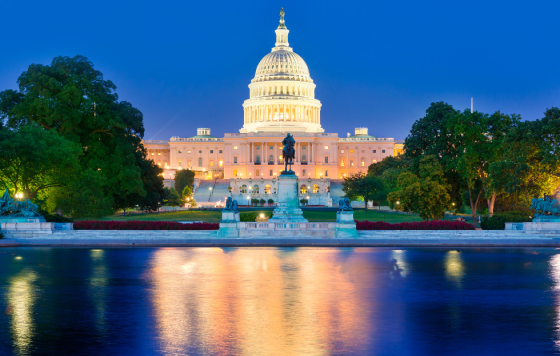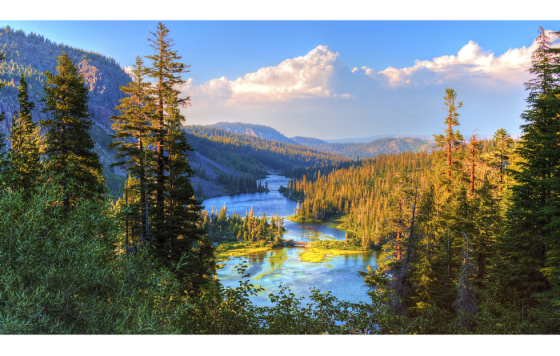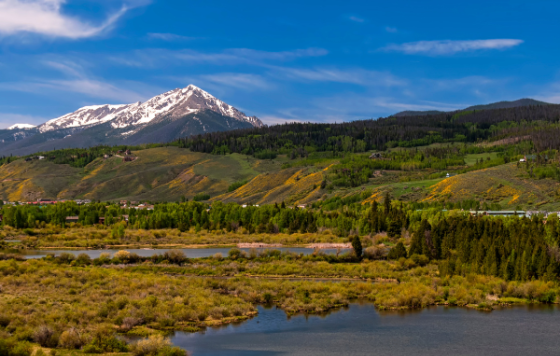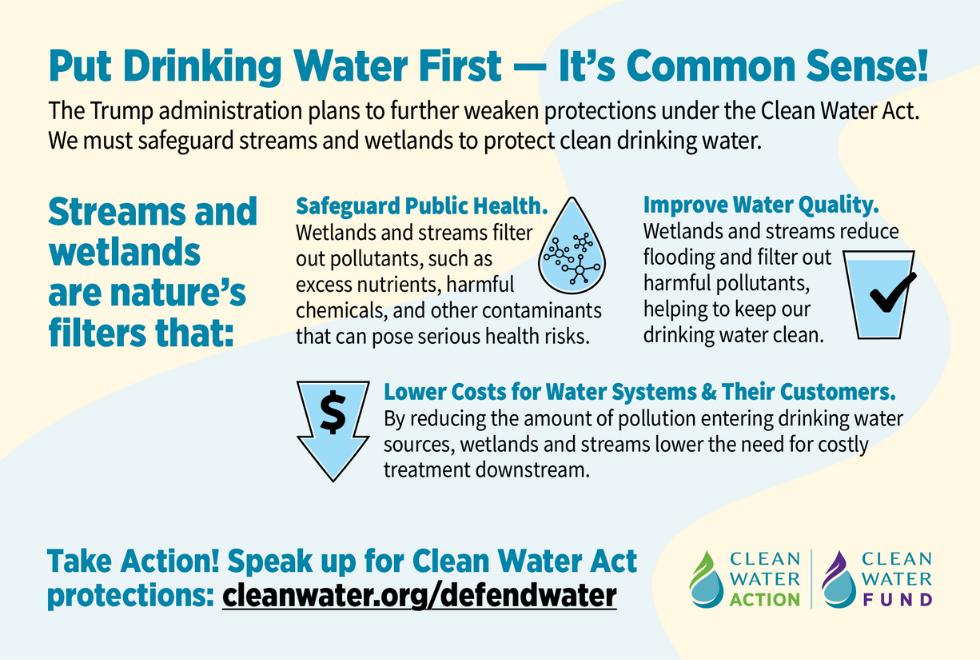
The Clean Water Act is intended to protect waterways from harmful pollutants, yet many streams and wetlands have lost their protections and others continue to be at risk. Streams and wetlands are more than just landscape features — they are critical parts of our natural water infrastructure that influence downstream water quality, including in drinking water sources. Relying solely on the Safe Drinking Water Act (SDWA), which sets limits on contaminants in tap water, is not sufficient for ensuring safe drinking water and places burdens on communities relying on polluted drinking water sources.
Clean Water’s Putting Drinking Water First approach means thinking about how upstream activities and the implementation of environmental regulations will impact downstream drinking water sources. Preventing pollution and the destruction of streams, wetlands, and other water bodies has multiple benefits, including improving source water quality, protecting public health, and lowering costs for water systems and their customers.
Streams, wetlands and other water bodies are complex systems that influence larger downstream water bodies.
Streams and wetlands improve water quality, filter out pollutants, absorb runoff, offer flood protection, help regulate the climate through carbon sequestration, and provide essential habitat for fish and other wildlife. The U.S. Environmental Protection Agency’s (EPA) Connectivity of Streams and Wetlands to Downstream Waters (Connectivity Report), a review and synthesis of numerous peer-reviewed scientific publications, highlighted the important role that wetlands, small streams, and other water bodies play in supporting the health of downstream water bodies.1 These findings were further bolstered in December 2022 when the U.S. Army Corps of Engineers (Corps) and EPA analyzed the conclusions of over 2,000 peer-reviewed papers published since the Connectivity Report, stating:
“...the evidence reviewed is conclusive: ephemerally, intermittently, and perennially flowing streams, floodplain wetlands and open waters, and non-floodplain wetland and open waters are hydrologically, biologically, chemically, and functionally connected to downstream systems and substantively and definitively affect down-gradient aquatic systems.”2
Streams and wetlands reduce contaminants of specific concern for drinking water quality.
Streams and wetlands filter out pollutants such as excess nutrients, harmful chemicals, and other contaminants, which can cause public health risks and impact Public Water Systems’ ability to comply with the Safe Drinking Water Act.

Nutrient pollution (nitrogen and phosphorus) is a good example of the potential downstream impacts of removing stream and wetland protections. In 2016, EPA’s Office of Water stated, “Nutrient pollution remains one of the greatest challenges to our Nation’s water quality and presents a growing threat to public health and local economies — contributing to toxic harmful algal blooms, contamination of drinking water sources, and costly impacts on recreation, tourism, and fisheries.”3 Algal blooms produce cyanotoxins which, at high levels, can cause severe illness and organ damage for wildlife and humans.4 For example, in Toledo, Ohio, a harmful algal bloom in 2014 led to a two-day “Do Not Drink” advisory for more than 500,000 consumers.5
Research shows that toxic algal blooms are growing in size. Using satellite imagery for over 2,000 large lakes and reservoirs across the country, the United States Geological Survey (USGS) found a 6.9% increase in spatial extent of harmful algal blooms between 2017 and 2020.6 Some states were found to have larger increases than others, such as New Jersey, which had a 24.75% increase in the spatial extent of harmful algal blooms. EPA’s Connectivity Report found that healthy small streams can remove as much as 20–40% of nitrogen pollution, capturing these nutrients before they can contribute to algal blooms in larger water bodies downstream.7 Protecting streams and wetlands is a crucial tool for reducing pollutants, such as nitrogen and phosphorus, in our waterways.
Streams feed the drinking water sources for over 117 million people.
More than 90% of Americans get their drinking water from Public Water Systems regulated under the Safe Drinking Water Act.8 Within that 90%, EPA estimates that 117 million Americans rely on drinking water sources that are supplied at least in part by intermittent, ephemeral, or headwater streams9—water resources that are now under serious threat. This estimate only considers streams; many more people rely on drinking water sources connected to wetlands. Further, pollution and disruption of streams and wetlands also impact the groundwater that is used by Public Water Systems and people relying on private wells.
There is overwhelming support for source water protection. The American Water Works Association (AWWA), the largest organization of water supply professionals in the world, released the 2024 State of the Water Industry report and ranked source water protection as the water sector’s most pressing challenge.10 At the 2024 United Nations Climate Change Conference (also known as COP29), the United Nations Environment Program (UNEP) called water one of our most valuable resources and emphasized the importance of protecting freshwater ecosystems.11 Protecting source water is a cost-effective way to prevent drinking water contamination, address serious public health concerns, reduce water service disruption, and lower the costs to Public Water Systems and their consumers.
Drinking water must be protected by strong Clean Water Act Programs.
There has been controversy over which streams, wetlands, and other water resources are covered under Clean Water Act pollution control programs (also known as “Waters of the United States” or WOTUS). Supreme Court rulings and policies enacted during the George W. Bush administration left water resources vulnerable to pollution. In 2015, the Obama administration’s Clean Water Rule broadened protections, but the Trump administration replaced it with the Navigable Waters Protection Rule (the NWPR), which significantly weakened Clean Water Act protections and became known informally as the “Dirty Water Rule.”12,13
In 2021, the Biden administration directed a review of the NWPR. The Corps and EPA determined that the significant reduction of protections under the Dirty Water Rule for ephemeral streams, wetlands, and other aquatic resources could “cause cascading, cumulative, and substantial downstream effects, including but not limited to effects on water supplies, water quality, flooding, drought, erosion, and habitat integrity.”14 In January 2023, the Corps and EPA restored the protections to wetlands and streams that were lost and established a durable definition of the water resources protected under the Clean Water Act based on overwhelming scientific evidence.15
However, in May 2023, the Supreme Court issued the devastating Sackett v. EPA decision, ruling that the Clean Water Act only protects “relatively permanent” bodies of water connected to navigable waters and wetlands that have “continuous surface connection” to other protected bodies of water.16 The Biden administration subsequently amended their ruling to follow the Sackett decision.17 This Supreme Court decision removed Clean Water Act protections for up to 63 percent of the nation’s wetlands and for thousands of miles of streams throughout the country.18 The ruling ignores the overwhelming scientific evidence that headwater, ephemeral and intermittent streams, and wetlands support the quality of downstream rivers and streams, including those that serve as drinking water sources.
Not only was this Supreme Court decision one of the largest setbacks for source water protections on the national scale, but the Trump administration and EPA now seek to reinterpret the Sackett v. EPA decision even more narrowly—putting even more wetlands and streams at risk. In March 2025, EPA and the Corps announced plans to revisit the definition of waters protected under the Clean Water Act.19
The Sackett v. EPA decision and the plans announced by the Trump administration directly ignore overwhelming scientific evidence that streams and wetlands are critical to maintaining water quality and clean drinking water. Protecting streams, wetlands, and other water bodies is a commonsense way to safeguard downstream drinking water sources. Putting Drinking Water First not only results in drinking water protection but leads to better choices which can prevent other environmental and economic impacts. The burden of higher water treatment costs from upstream polluters should not be put on downstream communities and their drinking water systems. Ultimately, the U.S. Congress needs to incorporate a robust and durable definition of “Waters of the United States” into the Clean Water Act to meet the goals of the Act and to protect the nation's water resources, including drinking water.
- Environmental Protection Agency, Office of Research and Development, Connectivity of Streams & Wetlands to Downstream Waters: A Review & Synthesis of the Scientific Evidence, EPA/600/R-14-475F, January 2015, http://cfpub.epa.gov/ncea/cfm/recordisplay.cfm?deid=296414.
- Department of the Army, Corps of Engineers, and Environmental Protection Agency, Technical Support Document for the Final “Revised Definition of ‘Waters of the United States’” Rule, December 2022, https://www.epa.gov/system/files/documents/2022-12/TSD-FinalCombined_508.pdf
- Joel Beauvais, Deputy Assistant Administrator, EPA, Memorandum to State Environmental Commissioners, State Water Directors, “Renewed Call to Action to Reduce Nutrient Pollution and Support for Incremental Actions to Protect Water Quality and Public Health,” September 22, 2016, https://www.epa.gov/sites/production/files/2016-09/documents/renewed-call-nutrient-memo-2016.pdf
- Environmental Protection Agency, “Learn about Harmful Algae, Cyanobacteria and Cyanotoxins” https://www.epa.gov/habs/learn-about-harmful-algae-cyanobacteria-and-cyanotoxins (Accessed March 18, 2025).
- Ohio Department of Higher Education (ODHE) Harmful Algal Bloom Research Initiative, 2024 Project Update, https://ohioseagrant.osu.edu/research/collaborations/habs (Accessed March 18, 2025).
- Schaeffer BA, Urquhart E, Coffer M, Salls W, Stumpf RP, Loftin KA, Werdell PJ. Satellites quantify the spatial extent of cyanobacterial blooms across the United States at multiple scales. Ecological Indicators, July 2022. https://doi.org/10.1016/j.ecolind.2022.108990.
- Environmental Protection Agency, Office of Research and Development, Connectivity of Streams & Wetlands to Downstream Waters: A Review & Synthesis of the Scientific Evidence, EPA/600/R-14-475F, January 2015, http://cfpub.epa.gov/ncea/cfm/recordisplay.cfm?deid=296414
- Centers for Disease Control and Prevention, “Drinking Water Sources: An Overview.” https://www.cdc.gov/drinking-water/about/drinking-water-sources-an-overview.html
- Environmental Protection Agency, Analysis of the Surface Drinking Water Provided By Intermittent, Ephemeral, and Headwater Streams in the U.S: County Results, July 2009.
- American Water Works Association, State of the Water Industry 2024 Report, July 19, 2024 https://www.awwa.org/wp-content/uploads/2024-SOTWI-Executive-Summary.pdf (Accessed March 18, 2025).
- Inger Andersen, United Nations Environment Program (UNEP), High-level opening of the Baku Dialogue on Water for Climate Action at the 2024 United Nations Climate Change Conference, November 21, 2024, https://www.unep.org/news-and-stories/speech/new-push-protect-water-our-most-valuable-resource (Accessed March 18, 2025).
- Department of the Army, Corps of Engineers, and Environmental Protection Agency, “Clean Water Rule: Definition of ‘Waters of the United States,’ Final Rule,” 80 Federal Register 37054-37127, June 29, 2015.
- Department of the Army, Corps of Engineers, and Environmental Protection Agency, “The Navigable Waters Protection Rule: Definition of ‘‘Waters of the United States,’’ Final Rule,” 85 Federal Register 22250, April 21, 2020.
- Department of the Army, Corps of Engineers, and Environmental Protection Agency, Memorandum for the Record: Review of U.S. Army Corps of Engineers ORM2 Permit and Jurisdictional Determination Data to Assess Effects of the Navigable Waters Protection Rule, June 8, 2021.
- Department of the Army, Corps of Engineers, Department of Defense; and Environmental Protection Agency (EPA), ‘Revised Definition of ‘‘Waters of the United States’’’, Final Rule, 88 Federal Register 3004, January 18, 2023.
- United States Supreme Court, Sackett v. EPA, 598 U.S., May 25, 2023.
- Department of the Army, Corps of Engineers, Department of Defense; and Environmental Protection Agency (EPA), ‘Revised Definition of ‘‘Waters of the United States’; Conforming’’, Final Rule, 88 Federal Register 61964, September 8, 2023.
- Public Webinar: Updates on the Definition of “Waters of the United States,” September 12, 2023, Environmental Protection Agency https://www.youtube.com/watch?v=lcCVelsAy2c (Accessed March 18, 2025).
- U.S. Department Of The Army, U.S. Army Corps Of Engineers And The U.S. Environmental Protection Agency, “Memorandum To The Field Between The U.S. Department Of The Army, U.S. Army Corps Of Engineers And The U.S. Environmental Protection Agency Concerning The Proper Implementation Of “Continuous Surface Connection” Under The Definition Of “Waters Of The United States” Under The Clean Water Act,” March 12, 2025.
